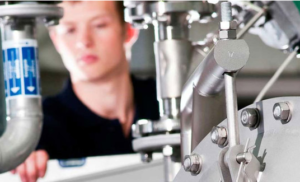Understanding when to use positive displacement (PD) pumps

positive displacement pump
When to use a positive displacement pump also known as a PD pump or a centrifugal pump isn’t always a clear choice. If you want to make the best choice between these types of pumps, it is important to know that these pumps behave differently. The PD pump has less or more constant flow regardless of the pressure while a centrifugal pump has variations in flow depending on the heat and pressure. Another difference between these two pumps is the effect of the viscosity on the capacity of the pump. Centrifugal pumps lose flow as the viscosity increases while PD pumps increase the flow.
It should also be noted that an increase in viscosity causes a greater resistance in the system. This means for a given flow at a higher viscosity, the pump should generate more pressure. When considering mechanical efficiency, it is important to note that the two pumps behave differently. Changes in pressure have a very small effect on the efficiency of the PD pump but a dramatic one on centrifugal pumps. Here are some reasons and circumstances why you should use a PD pump.
High viscosity applications
The most obvious reason to use PD pumps is when pumping fluids with high viscosity. It is common knowledge that centrifugal pumps become inefficient at modest viscosity. however, there are a lot of other reasons to choose a PD pump over using a centrifugal pump higher than the high viscosity of the fluid. Positive displacement pump types are very commonly used on thin liquids such as solvents and ammonia.
When operating a centrifugal pump other than at the BEP
You should consider using PD pumps when you are operating a centrifugal at other than at the BEP (best efficiency point). The further you get away from the best efficiency point, the more likely you have to choose a PD pump as your best choice. This can happen in very low flow conditions, modest to the high head conditions. It will take more horsepower to operate centrifugal pumps outside of its best efficiency point. This horsepower comes at a cost, the initial cost of a larger motor with a higher life cycle cost of energy consumed. A lot of times the PD pump has a lower initial cost and a lower operating cost compared to centrifugal pumps.
Variable pressure conditions
When your application has variable pressure conditions, you should consider using PD pumps. Centrifugal pumps walk up and down the curve and this can cause process problems. On the other hand, a PD pump gives a near-constant flow that makes it easy to match the flow to the requirements. The desire for a constant flow is the main reason why a PD pump should be used for metering applications.
When you require more pressure
A positive displacement pump can produce more pressure compared to centrifugal pumps. This depends on the design of the pump but PD pumps are known to generate a pressure of 20 Bar. Some models can go as high as 70 Bar. The PD pumps’ capacity to produce pressure is great to a point that some types of system overpressure protection may be required.







